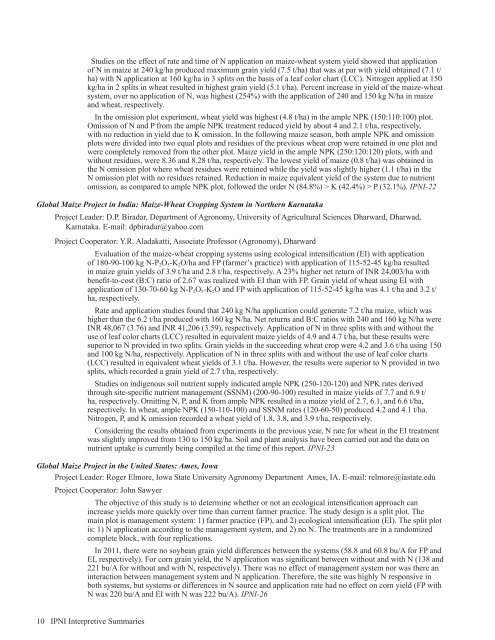Americas and Oceania Group - International Plant Nutrition Institute
Americas and Oceania Group - International Plant Nutrition Institute
Americas and Oceania Group - International Plant Nutrition Institute
Create successful ePaper yourself
Turn your PDF publications into a flip-book with our unique Google optimized e-Paper software.
Studies on the effect of rate <strong>and</strong> time of N application on maize-wheat system yield showed that application<br />
of N in maize at 240 kg/ha produced maximum grain yield (7.5 t/ha) that was at par with yield obtained (7.1 t/<br />
ha) with N application at 160 kg/ha in 3 splits on the basis of a leaf color chart (LCC). Nitrogen applied at 150<br />
kg/ha in 2 splits in wheat resulted in highest grain yield (5.1 t/ha). Percent increase in yield of the maize-wheat<br />
system, over no application of N, was highest (254%) with the application of 240 <strong>and</strong> 150 kg N/ha in maize<br />
<strong>and</strong> wheat, respectively.<br />
In the omission plot experiment, wheat yield was highest (4.8 t/ha) in the ample NPK (150:110:100) plot.<br />
Omission of N <strong>and</strong> P from the ample NPK treatment reduced yield by about 4 <strong>and</strong> 2.1 t/ha, respectively,<br />
with no reduction in yield due to K omission. In the following maize season, both ample NPK <strong>and</strong> omission<br />
plots were divided into two equal plots <strong>and</strong> residues of the previous wheat crop were retained in one plot <strong>and</strong><br />
were completely removed from the other plot. Maize yield in the ample NPK (250:120:120) plots, with <strong>and</strong><br />
without residues, were 8.36 <strong>and</strong> 8.28 t/ha, respectively. The lowest yield of maize (0.8 t/ha) was obtained in<br />
the N omission plot where wheat residues were retained while the yield was slightly higher (1.1 t/ha) in the<br />
N omission plot with no residues retained. Reduction in maize equivalent yield of the system due to nutrient<br />
omission, as compared to ample NPK plot, followed the order N (84.8%) > K (42.4%) > P (32.1%). IPNI-22<br />
Global Maize Project in India: Maize-Wheat Cropping System in Northern Karnataka<br />
Project Leader: D.P. Biradar, Department of Agronomy, University of Agricultural Sciences Dharward, Dharwad,<br />
Karnataka. E-mail: dpbiradar@yahoo.com<br />
Project Cooperator: Y.R. Aladakatti, Associate Professor (Agronomy), Dharward<br />
Evaluation of the maize-wheat cropping systems using ecological intensification (EI) with application<br />
of 180-90-100 kg N-P 2 O 5 -K 2 O/ha <strong>and</strong> FP (farmer’s practice) with application of 115-52-45 kg/ha resulted<br />
in maize grain yields of 3.9 t/ha <strong>and</strong> 2.8 t/ha, respectively. A 23% higher net return of INR 24,003/ha with<br />
benefit-to-cost (B:C) ratio of 2.67 was realized with EI than with FP. Grain yield of wheat using EI with<br />
application of 130-70-60 kg N-P 2 O 5 -K 2 O <strong>and</strong> FP with application of 115-52-45 kg/ha was 4.1 t/ha <strong>and</strong> 3.2 t/<br />
ha, respectively.<br />
Rate <strong>and</strong> application studies found that 240 kg N/ha application could generate 7.2 t/ha maize, which was<br />
higher than the 6.2 t/ha produced with 160 kg N/ha. Net returns <strong>and</strong> B:C ratios with 240 <strong>and</strong> 160 kg N/ha were<br />
INR 48,067 (3.76) <strong>and</strong> INR 41,206 (3.59), respectively. Application of N in three splits with <strong>and</strong> without the<br />
use of leaf color charts (LCC) resulted in equivalent maize yields of 4.9 <strong>and</strong> 4.7 t/ha, but these results were<br />
superior to N provided in two splits. Grain yields in the succeeding wheat crop were 4.2 <strong>and</strong> 3.6 t/ha using 150<br />
<strong>and</strong> 100 kg N/ha, respectively. Application of N in three splits with <strong>and</strong> without the use of leaf color charts<br />
(LCC) resulted in equivalent wheat yields of 3.1 t/ha. However, the results were superior to N provided in two<br />
splits, which recorded a grain yield of 2.7 t/ha, respectively.<br />
Studies on indigenous soil nutrient supply indicated ample NPK (250-120-120) <strong>and</strong> NPK rates derived<br />
through site-specific nutrient management (SSNM) (200-90-100) resulted in maize yields of 7.7 <strong>and</strong> 6.9 t/<br />
ha, respectively. Omitting N, P, <strong>and</strong> K from ample NPK resulted in a maize yield of 2.7, 6.1, <strong>and</strong> 6.6 t/ha,<br />
respectively. In wheat, ample NPK (150-110-100) <strong>and</strong> SSNM rates (120-60-50) produced 4.2 <strong>and</strong> 4.1 t/ha.<br />
Nitrogen, P, <strong>and</strong> K omission recorded a wheat yield of 1.8, 3.8, <strong>and</strong> 3.9 t/ha, respectively.<br />
Considering the results obtained from experiments in the previous year, N rate for wheat in the EI treatment<br />
was slightly improved from 130 to 150 kg/ha. Soil <strong>and</strong> plant analysis have been carried out <strong>and</strong> the data on<br />
nutrient uptake is currently being compiled at the time of this report. IPNI-23<br />
Global Maize Project in the United States: Ames, Iowa<br />
Project Leader: Roger Elmore, Iowa State University Agronomy Department Ames, IA. E-mail: relmore@iastate.edu<br />
Project Cooperator: John Sawyer<br />
The objective of this study is to determine whether or not an ecological intensification approach can<br />
increase yields more quickly over time than current farmer practice. The study design is a split plot. The<br />
main plot is management system: 1) farmer practice (FP), <strong>and</strong> 2) ecological intensification (EI). The split plot<br />
is: 1) N application according to the management system, <strong>and</strong> 2) no N. The treatments are in a r<strong>and</strong>omized<br />
complete block, with four replications.<br />
In 2011, there were no soybean grain yield differences between the systems (58.8 <strong>and</strong> 60.8 bu/A for FP <strong>and</strong><br />
EI, respectively). For corn grain yield, the N application was significant between without <strong>and</strong> with N (138 <strong>and</strong><br />
221 bu/A for without <strong>and</strong> with N, respectively). There was no effect of management system nor was there an<br />
interaction between management system <strong>and</strong> N application. Therefore, the site was highly N responsive in<br />
both systems, but systems or differences in N source <strong>and</strong> application rate had no effect on corn yield (FP with<br />
N was 220 bu/A <strong>and</strong> EI with N was 222 bu/A). IPNI-26<br />
10 IPNI Interpretive Summaries

















